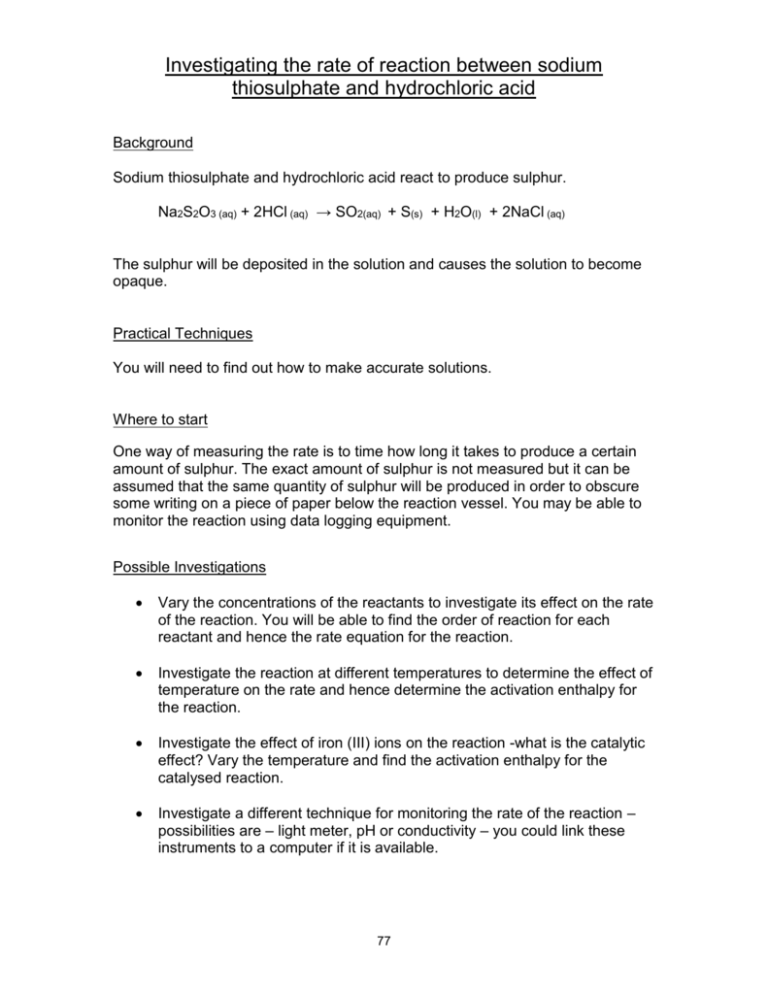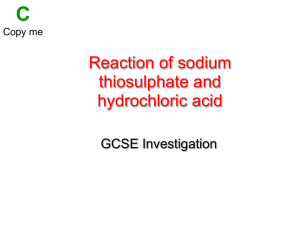Investigating the rate of reaction between sodium thiosulphate and
advertisement

Investigating the rate of reaction between sodium thiosulphate and hydrochloric acid Background Sodium thiosulphate and hydrochloric acid react to produce sulphur. Na2S2O3 (aq) + 2HCl (aq) → SO2(aq) + S(s) + H2O(l) + 2NaCl (aq) The sulphur will be deposited in the solution and causes the solution to become opaque. Practical Techniques You will need to find out how to make accurate solutions. Where to start One way of measuring the rate is to time how long it takes to produce a certain amount of sulphur. The exact amount of sulphur is not measured but it can be assumed that the same quantity of sulphur will be produced in order to obscure some writing on a piece of paper below the reaction vessel. You may be able to monitor the reaction using data logging equipment. Possible Investigations Vary the concentrations of the reactants to investigate its effect on the rate of the reaction. You will be able to find the order of reaction for each reactant and hence the rate equation for the reaction. Investigate the reaction at different temperatures to determine the effect of temperature on the rate and hence determine the activation enthalpy for the reaction. Investigate the effect of iron (III) ions on the reaction -what is the catalytic effect? Vary the temperature and find the activation enthalpy for the catalysed reaction. Investigate a different technique for monitoring the rate of the reaction – possibilities are – light meter, pH or conductivity – you could link these instruments to a computer if it is available. 77 Sources of Information The Chemistry Video Consortium and The Royal Society of Chemistry (2000) Practical Chemistry for Schools and Colleges CD ROM Thorpe A, Making a standard solution, Chemistry Review, November 2002 Lindsey D, Measuring pH, Chemistry Review, September 1998 Ferguson M., Volumetric Analysis. Chemistry Review, September 1996 Farley R., (2001), School Chemistry Experiments, Association for Science Education. http://users.erols.com/merosen/kinetics.htm Vokins M. (ed), (1994), Nuffield Advanced Science Chemistry Students Book, Longman (Third edition) Turner J.W., The activation energy of the thiosulphate-acid reaction, School Science Review, June 1972, Vol 53, No 185, p.751 Thorpe A., Assessing the risks in practical work, Chemistry Review, September 2000 Thorpe A., Experimental error and error analysis: just how good are those results, Chemistry Review, November 2001 78 Teachers' Notes General This investigation is based around a well-known reaction that can be found in many chemistry books. It is an experiment that is often carried out at GCSE level and therefore teachers must make students aware that they need to approach this investigation at the appropriate level. The practical techniques are very simple and students should be able to obtain accurate results quite easily. The manipulative skills required for the basic experiment are not very demanding. Nitric acid or sulphuric acid can be used in place of hydrochloric acid. Sources suggest that the order of reaction is between zero and first depending on the concentration of acid. Chemical Principles Acids, reaction kinetics. Essential Equipment Burettes, pipettes. Essential Chemicals Hydrochloric acid, sodium thiosulphate. Safety No risk assessment has been given. It is essential that students prepare a detailed risk assessment before they start. Teachers must be satisfied that this is suitable for the proposed investigation. 79 Experiment Starter Sheet - Investigating the rate of reaction between sodium thiosulphate and hydrochloric acid Here is a suggested method to investigate the effect of varying the concentration of sodium thiosulphate. Prepare the following solutions Hydrochloric acid 0.1 mol dm-3 Sodium thiosulphate 1 mol dm-3 You will need to think about how much of each solution to prepare. This will depend on how much of each solution is used in each experiment and how many experiments you do (including any repeats). Use pipettes and /or burettes to put the following solutions into a suitable reaction vessel. Do not add the acid until you are ready to record the time for the reaction to start. Place a mark on the reaction vessel or on a piece of paper. Time how long it takes for the mark to become obscured. Expt Water (cm3) 1 2 3 4 5 8 6 4 2 0 Sodium thiosulphate (cm3) 2 4 6 8 10 Hydrochloric acid (cm3) 10 10 10 10 10 . The rate of the reaction can be determined by the calculating the amount of sulphur produced in the time recorded. This is given by Rate = Amount of sulphur Time Amount of sulphur is assumed to be the same in each reaction so Rate = 1 _ Time This information can be used to determine the order of the reaction with respect to sodium thiosulphate. 80











